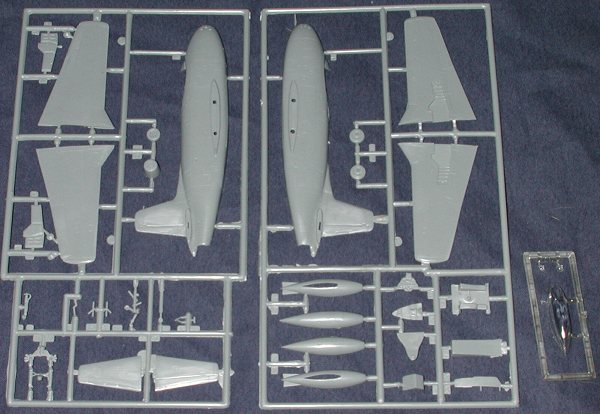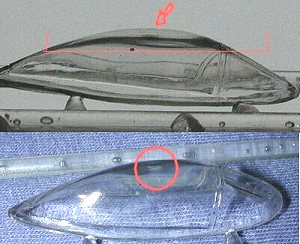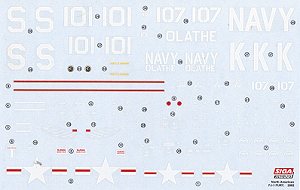
|
KIT: |
SIGA 1/72 FJ-1 Fury |
|
KIT # |
72011 |
|
PRICE: |
$ |
|
DECALS: |
Two Aircraft |
|
REVIEWER: |
|
|
NOTES: |

|
HISTORY |
The FJ-1 was North American Aviation's first foray into jet fighters. What makes it particularly interesting is that this is a Navy jet, and North American was more of a USAAF aircraft provider. However, it had a reputation for producing quality products as can be seen by the success of the T-6, B-25 and P-51, aircraft that are still flying today, some 60 years after they first flew.
Naval requirements for aircraft have always been somewhat different from the Army or Air Force. First of all, they have to have more rugged airframes to withstand the additional stresses of catapult launches and arrested landings. This means that they are generally heavier and have more robust landing gear. More weight is added by the arresting hook and, for some types, folding wings. There is also the need to have a relatively slow landing speed as there isn't a runway of several thousand feet available. This meant a more conservative design.
The FJ-1 had all those traits. In fact, it was little more than a jet powered WWII fighter with its straight wings and 6 .50 calibre machine guns. It didn't have folding wings, but did have a folding nose gear to assist with below deck storage. Less than 100 were built as technology was such that a plane was nearly obsolete by the time it first flew. However, the Fury did enter fleet service with VF-5 (later VF-51) before it was passed on to a few Naval Reserve units at Oakland, CA and Olathe, KS. It also allowed the Navy to work out any bugs with the operation of jet powered aircraft, and the aircraft provided a basis for the wildly successful F-86 Sabre that was a direct descendant.
|
THE KIT |

 According to the fine folks at SIGA,
this is their first home-brewed kit. When one opens the box, one notices quite a
few differences from their second kit, the AM-1. First of all, it is in a dark
grey (vice white) plastic. Secondly, the plastic in this kit is much thinner
than the more recent Mauler. Detailing is finer and the sprue attachment
points smaller. It is still a short run kit as there is some flash and also a
bit of 'lumpiness' to the upper wing sections, particularly around the ailerons.
My sample also had a slightly short shot right fuselage back at the exhaust. Not
a problem that cannot be repaired by most of us. What cannot be repaired is the
canopy. My copy is very thick at the top and has a sink mark in it as well. The
only cure for this is to fill the sink mark and use the kit canopy as a master
to make a vac copy. It may be an isolated problem and has been brought to the
attention of the folks at SIGA.
According to the fine folks at SIGA,
this is their first home-brewed kit. When one opens the box, one notices quite a
few differences from their second kit, the AM-1. First of all, it is in a dark
grey (vice white) plastic. Secondly, the plastic in this kit is much thinner
than the more recent Mauler. Detailing is finer and the sprue attachment
points smaller. It is still a short run kit as there is some flash and also a
bit of 'lumpiness' to the upper wing sections, particularly around the ailerons.
My sample also had a slightly short shot right fuselage back at the exhaust. Not
a problem that cannot be repaired by most of us. What cannot be repaired is the
canopy. My copy is very thick at the top and has a sink mark in it as well. The
only cure for this is to fill the sink mark and use the kit canopy as a master
to make a vac copy. It may be an isolated problem and has been brought to the
attention of the folks at SIGA.
With only 43 parts, this is not a complicated kit, but the aircraft was pretty simple as well. You have basically one option and that is the wing tip tanks. However, they are shown in the instructions as not to be used for this particular boxing. Having said that, the tanks could be fit to the plane at any time so if you want to use them, it wouldn't be 'wrong'.
 Typical of SIGA, the instructions
have a main set of construction sequences with sub assemblies segregated to the
right side of the sheet. Painting information is provided where needed.
The model will need nose weight and SIGA suggests 4 grams. I'd put in more just
to be sure. There is lots of room. Deals are provided for two aircraft; one from
VF-51 and the other from the reserve unit at Olathe, KS. Both are overall dark
sea blue with the Kansas bird having a bright orange fuselage band. The decals
are well printed and if like the Mauler ones will be very thin, very opaque and
stick very well. SIGA made an effort to improve decals over the last year and
the results have been exceptional as they are among the best I've ever used.
Typical of SIGA, the instructions
have a main set of construction sequences with sub assemblies segregated to the
right side of the sheet. Painting information is provided where needed.
The model will need nose weight and SIGA suggests 4 grams. I'd put in more just
to be sure. There is lots of room. Deals are provided for two aircraft; one from
VF-51 and the other from the reserve unit at Olathe, KS. Both are overall dark
sea blue with the Kansas bird having a bright orange fuselage band. The decals
are well printed and if like the Mauler ones will be very thin, very opaque and
stick very well. SIGA made an effort to improve decals over the last year and
the results have been exceptional as they are among the best I've ever used.
|
CONCLUSIONS |
Other than the problem with the canopy, this is a very nice kit. No, it isn't a Tamiyagawa kit, but then, those folks probably wouldn't produce an FJ-1. As a short run kit is one that I can recommend to those who are seeking to try one out. It's basic construction and lack of fiddly bits are such that it should be a satisfying build.
Thanks to SIGA for the review kit.
If you would like your product reviewed fairly and quickly where it will be seen by well over 150,000 visitors a month, please contact me or see other details in the Note to Contributors.